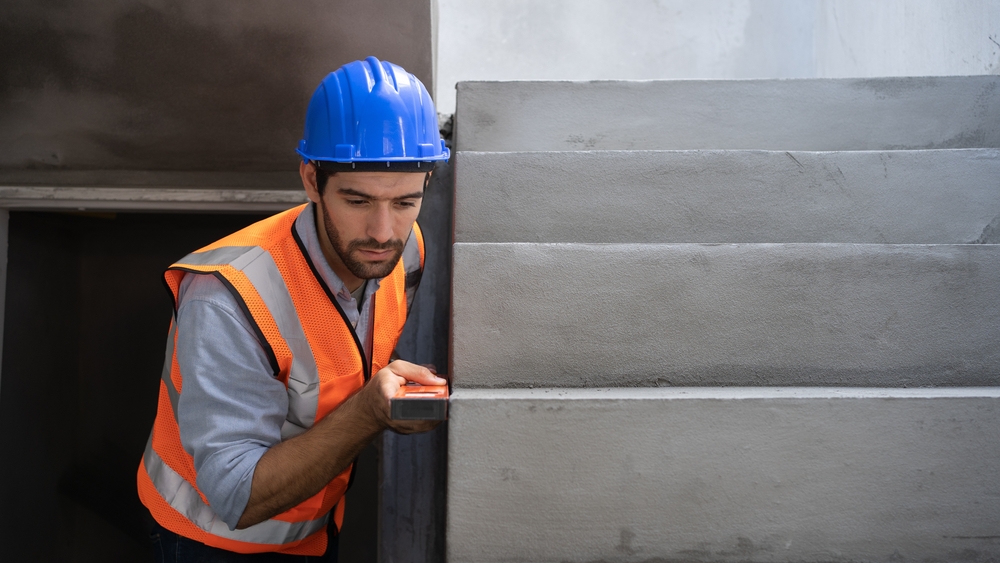Concrete is often taken for granted until it shows signs of damage, but being proactive about inspections can save you both time and money in the long run.
It’s essential to check your concrete surfaces for wear, especially after severe weather or if they’re subjected to heavy foot or vehicle traffic.
Regular assessments, ideally annually, help catch problems early. Knowing when to schedule these inspections and what specific signs of damage to watch for can significantly extend the life of your concrete surfaces and keep your property looking its best.
Signs of Concrete Deterioration
Proactive inspection can help identify issues before they become major problems. Key signs of concrete deterioration include:
Cracks:
- Small cracks: May not require immediate attention.
- Large, extensive cracks: Can indicate serious structural issues.
Flaking or Spalling:
- Surface deterioration: Chips and pieces of concrete breaking away.
- Caused by: Moisture infiltration, freeze-thaw cycles.
Discoloration or Stains:
- Potential indicators of: Water damage, chemical exposure.
- Can compromise: Concrete’s structural integrity.
Uneven Surfaces and Settling:
- Can lead to: Further structural problems.
Efflorescence:
- White powdery substance: Sign of moisture movement within the concrete.
- Can weaken: Concrete over time.
By regularly inspecting your concrete surfaces and addressing these signs promptly, you can prevent costly repairs and ensure the long-term health and safety of your property.
Timing for Inspections
Regular Inspections:
- At least once a year: Especially important in areas with extreme weather conditions.
- After heavy storms: To assess potential water damage.
Increased Frequency for High-Traffic Areas: More frequent inspections for areas with heavy foot or vehicle traffic.
Proactive Approach: Address any signs of wear or damage promptly to prevent further deterioration.
When in Doubt: Schedule an inspection if you have any concerns about the condition of your concrete.
By following these inspection guidelines, you can proactively identify and address potential issues, ensuring the safety, functionality, and longevity of your concrete surfaces.
Benefits of Regular Inspections
Regular inspections offer significant advantages for property owners:
Peace of Mind
- Early identification of potential issues provides reassurance.
- Reduces anxiety associated with potential structural problems.
Cost Savings
- Early detection of issues leads to less expensive repairs.
- Prevents costly replacements and major renovations.
- Extends the lifespan of your concrete structures.
Enhanced Safety
- Identifies and addresses potential safety hazards like trip and fall risks.
- Minimizes the risk of accidents and injuries.
Improved Aesthetics
- Well-maintained concrete enhances the overall appearance of your property.
- Increases curb appeal for potential buyers or renters.
Regulatory Compliance
- Ensures compliance with local building codes and regulations.
- Avoids costly fines and legal penalties.
Expert Guidance
- Provides valuable insights and recommendations from experienced professionals.
- Tailored maintenance plans for your specific concrete needs.
Regular concrete inspections are a valuable investment in the long-term health, safety, and value of your property. By prioritizing these proactive checks, you can enjoy the peace of mind that comes with knowing your concrete is in good condition and protected from potential issues.
Scheduling regular concrete inspections is crucial for maintaining the integrity and safety of your property.
By proactively addressing any signs of wear or damage, you can avoid costly repairs, improve the longevity of your concrete surfaces, and ensure your property remains safe and visually appealing.
Whether through annual assessments or after severe weather events, inspections offer peace of mind, cost savings, and enhanced compliance with local regulations. Taking a proactive approach now will protect your investment and avoid larger issues down the road.

